Abstract
Previous study has shown a likely link between increased shoe- surface traction and risk of knee Anterior Cruciate Ligament (ACL) injury. Portable natural grass systems are being used more often in sport, but no study to date has investigated their relative safety. By their nature, they must have high resistance to falling apart and therefore newly laid systems may be at risk of creating excessive shoe-surface traction. This study describes two clusters of knee injuries (particularly non-contact ACL injuries), each occurring to players of one professional football team at single venue, using portable grass, in a short space of time. The first series included two ACL injuries, one posterolateral complex disruption and one lateral ligament tear occurring in two rugby league games on a portable bermudagrass surface in Brisbane, Australia. The second series included four non-contact ACL injuries over a period of ten weeks in professional soccer games on a portable Kentucky bluegrass/perennial ryegrass surface in Barcelona, Spain. Possible intrinsic risk factors are discussed but there was no common risk shared by the players. Although no measures of traction were made at the Brisbane venue, average rotational traction was measured towards the end of the injury cluster at Camp Nou, Barcelona, to be 48 Nm. Chance undoubtedly had a part to play in these clusters, but the only obvious common risk factor was play on a portable natural grass surface soon after it was laid. Further study is required to determine whether portable natural grass systems may exhibit high shoe-surface traction soon after being laid and whether this could be a risk factor for knee injury.
Key points.
Excessive shoe-surface traction is a hypothesised risk factor for knee ligament injuries, including anterior cruciate ligament injuries.
Portable natural grass systems (by their nature in order to prevent grass rolls or squares from falling apart) will tend to exhibit high resistance to tearing when first laid. This may lead to excessive shoe-surface traction.
This dual case series describes two clusters of non-contact knee ligament injuries which occurred in circumstances of newly laid portable turf.
Further research is warranted to undercover any link between non-contact knee ligament injuries and ground surfaces conditions.
Key words: Anterior cruciate ligament, bermudagrass, perennial ryegrass, Kentucky bluegrass
Introduction
Anterior Cruciate Ligament (ACL) injuries of the knee are the most costly injuries in the various codes of football played around the world, because they are both common and severe (Agel et al., 2005; Griffin et al., 2006; Orchard and Powell, 2003). At professional levels of football, ACL injuries generally need to be treated surgically with ACL reconstruction, forcing affected players to miss at least six months of playing time (Orchard et al. , 2001). Studies of ACL injury generally divide the mechanism of injury into contact and non-contact. A contact injury is one where there is contact to the injured leg by another player, whereas a non- contact injury occurs without contact to the injured leg (Orchard et al., 2001). Non-contact mechanism ACL injuries are thought to possibly implicate poor athlete biomechanics and/or the playing surface, as the forces causing the injury are created by internal muscle contractions and shoe-surface interaction forces only.
In the majority of countries of the world, the term football refers to the sport which is also known as soccer. However, there are at least six major distinct football ‘codes’ or different varieties of football played around the world. Rugby league is a full contact football code, being most similar to rugby union although also sharing some features with American football. There are 13 players per side on the field at any time (6 forwards and 7 backs). At professional level, both soccer and rugby league are generally played on natural grass surfaces. Despite the differences between soccer and rugby league as sports, ACL injuries are common and severe in both codes and more often than not occur with a non- contact mechanism.
Potential risk factors for ACL injuries can be divided into intrinsic (player-related) and extrinsic (non-player related) factors (Griffin et al., 2006; Orchard et al., 2001). Intrinsic risk factors can be subdivided into non-reversible factors (sex, family history, past history, size of notch and ligament) and potentially reversible factors (landing and movement patterns, muscle weakness). Extrinsic risk factors can be divided into various categories such as footwear, playing surface, rules and refereeing. Female sex (Arendt et al., 1999, Arendt and Dick, 1995), smaller ACL ligament size (Shelbourne et al., 1997; 1998) and past history of ACL injury (Orchard et al., 2001a) are established risk factors, although all are non-reversible. Movement patterns with increased knee valgus (Hewett et al., 2005) and increased shoe-surface traction (Orchard and Powell, 2003) are less clearly established but are likely risk factors which have the potential to be reversed. The two main surface characteristics that may relate to knee injury in football are hardness (the effect that the surface has on absorbing impact energy) and rotational traction (the type of footing or ‘grip’ a playing surface provides) (Ekstrand and Nigg, 1989; Milburn and Barry, 1998; Nigg and Segesser, 1988; Rogers and Waddington, 1990).
Methods
This study describes two clusters of primarily non-contact knee injuries (particularly ACL injuries), each occurring to players of one football team at one particular venue in a short space of time. The first cluster involves players of the Sydney Roosters NRL (National Rugby League, Australia) team occurring at Suncorp Stadium in Brisbane Australia during 2003; the second cluster involves players of the FC Barcelona team occurring at Camp Nou stadium (Barcelona, Spain) in 2004. This dual case series was conceived by the authors of this study who are for the most part from the medical staff of both teams. Collaboration was made during a visit in January 2006 to Barcelona by the primary author.
All injury details are reproduced from contemporaneous case notes, with attached videos made available by the team coaching and video staff.
Results
Sydney Roosters case series
The Sydney Roosters play one match per week in the National Rugby League (NRL) competition with their home ground being Sydney Football Stadium in Sydney (34° S). This is a rugby league stadium in a temperate climate with a surface which has a bermudagrass (Cynodon dactylon) base oversown with perennial ryegrass (Lolium perenne). In June (which is the first month of winter in Australia) the ryegrass is the predominant species as Sydney overnight temperatures have generally dropped to around 10 degrees C, at which point bermudagrass has started to become dormant.
In June of the NRL season, the best Australian players are also selected to play in the representative State of Origin series between New South Wales and Queensland.
This case series involves two matches played at Suncorp Stadium in Brisbane (27° S), one State of Origin match on June 11, 2003 (in which there were seven Sydney Roosters participating) and one NRL match between the Brisbane Broncos and Sydney Roosters on June 27, 2003. Both of these games were played in the evening on a bermudagrass surface. Brisbane has a warm temperature, and is often described as having a subtropical climate.
Case 1
Diagnosis: Left knee complete anterior cruciate ligament rupture plus lateral meniscal tear.
Date: June 11, 2003.
Time: Early in second half.
Mechanism: Carrying the ball, tried to sidestep to avoid a potential tackler and his left knee buckled with his boot fixed in the ground, no player contact involved (Video 1, Available from URL: http://www.jssm.org/vol7/n1/26/v/case1.html).
Player details: Age 21yr, height 1.88m, weight 95kg.
Boots used: Adidas moulded blades. Past injury history: Nil relevant.
Outcome: Had a knee reconstruction (patellar tendon autograft) and partial lateral menisectomy. Missed the remainder of the 2003 NRL season but he returned to play the majority of season 2004, with no further knee problems.
Case 2
Diagnosis: Left knee complete rupture of lateral ligament, biceps femoris tendon, and postero-lateral complex.
Date: June 27, 2003.
Time: Early in first half.
Mechanism: Carrying the ball, was tackled to the upper body and planted his left foot. The foot appeared to stick in the turf and his knee hyperextended 30 degrees with no player contact to the leg (Video 2, Available from URL: http://www.jssm.org/vol7/n1/26/v/case2.html).
Player details: Age 26 yr, height 1.90m, weight 102kg. Boots used: Puma King moulded blades.
Past injury history: He had missed 4 weeks with a left knee medial ligament strain in 2002, although his medial ligament was not re-injured in the current injury.
Outcome: He had a direct repair of his ligament, tendon and postero-lateral complex. Missed the following 11 weeks, although returned to play in the 2003 NRL Finals. Suffered a recurrence of the same injury early in 2004 on a different ground (Telstra Stadium) with the same mechanism, although only missed 4 weeks on this occasion and did not require surgery. Has not had knee problems since.
Case 3
Diagnosis: Grade 2 strain of left knee lateral ligament.
Date: June 27, 2003.
Time: Middle of first half.
Mechanism: Carrying the ball, was tackled to the upper body and the left knee was levered with his boot on the ground, then he fell into the tackle. It is probable but not certain that surface contact rather than player contact was the injury mechanism (Video 3, Available from URL: http://www.jssm.org/vol7/n1/26/v/case3.html).
Player details: Age 21yr, height 1.79m, weight 82kg. Boots used: Puma.
Past injury history: Nil relevant.
Outcome: Did not require surgery and returned to play in 4 weeks, with no further problems thereafter.
Case 4
Diagnosis: Right knee anterior cruciate ligament rupture plus small lateral meniscal tear (Figure 1).
Figure 1.
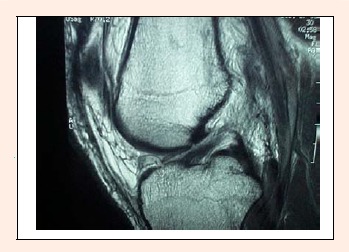
MRI scan of ruptured ACL in case 4.
Date: June 27, 2003.
Time: Late in first half.
Mechanism: Carrying the ball, was tackled in the upper body with the right foot fixed in the ground, and then swung around with another player’s knee hitting his right calf. Even with video analysis, it is uncertain whether the injury occurred with the foot on the playing surface, or due to the direct blow to the leg, when the foot was free (Video 4, Available from URL: http://www.jssm.org/vol7/n1/26/v/case4.html).
Player details: Age 26yr, Height 1.93m, Weight 107kg. Boots used: Adidas Soft Ground blades with screw-in component.
Past injury history: He had a grade 1 left knee medial sprain in 2002 for which he did not miss a game. Outcome: Attempted to return to play rugby league 3 weeks later, despite the known ACL injury, as he had survived the remainder of the game in which he was injured. However, in his next game he had a major giving way episode and was forced to have reconstruction surgery (patellar tendon autograft) and miss the remainder of the 2003 season. Returned to play in early 2004 and had minimal problems with the knee.
Although not subjects for this case series, two other NRL players (not from the Sydney Roosters team) also suffered major knee medial ligament injuries over the space of the first three games (six team-games) on the new surface. The rate of knee ligament injuries on Suncorp Stadium for the first three matches played suggests that chance alone is unlikely to account for the higher rate of these injuries. Based on prior injury incidence at the Sydney Roosters (Orchard, 2004), the expected number of knee ligament injuries is a rate of 7 per 1000 player games in the NRL. The higher rate of knee ligament injury at Suncorp Stadium in the first three matches was therefore unlikely to have been due to chance (6 in 78 player games, p < 0.001, χ2 test).
The playing surface at Suncorp Stadium, when first laid, was unusual and atypical (Figure 2). The playing surface was made up of turfgrass brought in on portable squares. These squares when laid down were apparently of inconsistent height after laying and therefore on the playing surface there were originally ridges of greater than 1cm height between the demarcations of the laid squares. Due to inadequate time after the laying of these squares to flatten the surface out, construction staff apparently decided to heavily topdress the ground with sand in order to flatten to playing surface.
Figure 2.
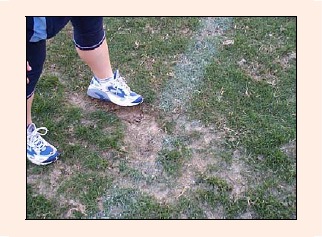
The sandy surface at Suncorp stadium a month after it opened in June 2003.
FC Barcelona case series
Barcelona is a temperate Mediterranean city in Catalonia, Spain (41° N). The FC Barcelona club plays matches in the Spanish League plus various other domestic and international leagues. As the majority of the season is played over winter, the playing surface is made up of cool-season grasses. In 2004, a portable square system using a mix of Kentucky Bluegrass, or smooth-stalked meadow grass (Poa pratensis) and perennial ryegrass was used. The grass was laid in portable squares in the second week of August 2004, days after the stadium had been used for a rock concert.
Case 5
Diagnosis: Right knee anterior cruciate plus medial ligament rupture.
Date: September 11th, 2004;
Time: Early in first half.
Mechanism: Non-contact changing direction (Video 5, Available from URL: http://www.jssm.org/vol7/n1/26/v/case5.html).
Player details: Age 23yr, height 1.88m, weight 83kg. Boots used: Moulded sole (Figure 3).
Figure 3.
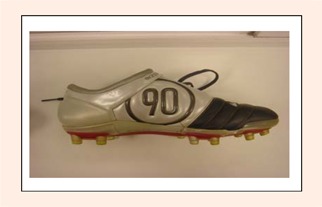
Boots worn by player in case 5.
Relevant past history: Grade 1 MCL R knee on July 18th, 2004 (returned to play on August 8th, 2004 without problems for the next month); previous patella tendinopathy.
Outcome: Reconstructed with an autologous patella tendon ACL graft on September 27th, returned to play April 17th, 2005 with no further knee problems.
Case 6
Diagnosis: Right knee anterior cruciate plus medial ligament rupture, lateral meniscal tear.
Date: September 23rd, 2004;
Time: Early in first half.
Mechanism: Non-contact changing direction (Video 6, Available from URL: http://www.jssm.org/vol7/n1/26/v/case6.html).
Player details: Age 27yr, height 1.74m, weight 80kg. Boots used: Screw in (Figure 4).
Figure 4.
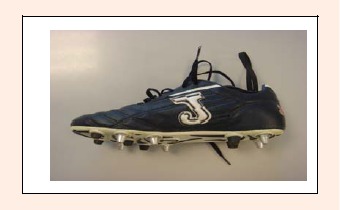
Boots worn by player in case 6.
Relevant past history: Right medial collateral ligament sprain in May 2004.
Outcome: Had autologous patella tendon ACL graft performed and returned to play May 22nd, 2005 with no further knee problems.
Case 7
Diagnosis: Right knee anterior cruciate ligament rupture plus medial meniscal tear.
Date: October 3rd, 2004.
Time: Early in first half.
Mechanism: Indirect (non)-contact landing (Video 7, Available from URL: http://www.jssm.org/vol7/n1/26/v/case7.html).
Player details: Age 28yr, height 1.85m, weight 78kg. Boots used: Screw-in (Figure 5).
Figure 5.
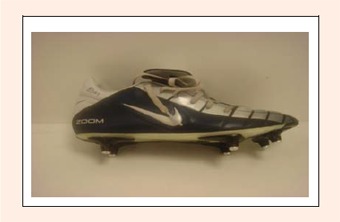
Boots worn by player in case 7.
Relevant past history: Left patellar tendinopathy.
Outcome: Had autologous hamstring tendon ACL graft + meniscal repair with anchors performed; returned to play May 22nd, 2005 with no further knee problems.
Case 8
Diagnosis: Left knee anterior cruciate ligament rupture plus osteochondral fracture.
Date: November 20th, 2004.
Time: In the middle of the second half.
Mechanism: Non-contact changing direction (Video 8, Available from URL: http://www.jssm.org/vol7/n1/26/v/case8.html).
Player details: Age 34yr, height 1.78m, weight 74kg. Boots used: Screw-in (Figure 6).
Figure 6.
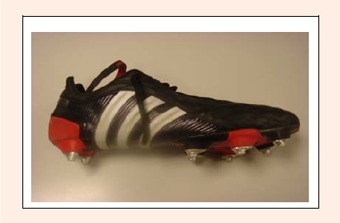
Boots worn by player in case 8.
Relevant past history: Left tibial fracture (nailed) in 1999. Outcome: Arthroscopic removal of loose body performed the following day. Had a donor patella tendon ACL graft on December 3rd, returned to play May 22nd, 2005 with no further knee problems.
There were some associated factors shared by the four Barcelona players. All four players for different reasons did not undergo a full preseason. The average of minutes played for these players during preseason matches was 300 (compared to an average of 550 minutes for the entire squad). All players underwent a specific training programme to increment strength in quadriceps and hamstrings muscle groups and a proprioceptive program with unstable and vibrational platforms.
In October 2004 (after the third injury in this cluster) the IBV (Valencia biomechanics institute), a centre accredited for FIFA and UEFA, was called upon to analyse the grass parameters of the Camp Nou main field (Figures 7 and 8) compared to the training field (Gamez et al., 2004). In comparison with the training field (La Masia) the Campn Nou grass had greater hardness, measured as less impact absorption (42% compared to 53%, p < 0.001) and higher rotational traction (48 Nm compared to 39 Nm, p < 0.001). As traction values tend to fall over the course of the playing season (Chivers et al., 2005), it is likely that the rotational traction value may have been higher than this if measured in September.
Figure 7.
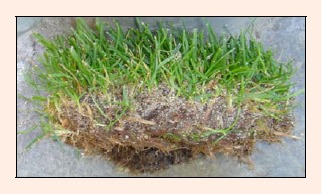
A section of grass from Camp Nou Camp stadium in Barcelona (2004) indicating thick thatch layer.
Discussion
These two clusters have certain associated factors which were similar, although there were many differences between the two groups (Table 1). The common similarity for both groups was that both playing surfaces were newly laid with portable squares, although the grass composition for the two surfaces was different (bermudagrass at Suncorp stadium; Kentucky bluegrass and perennial ryegrass mix at Camp Nou). At both venues, there was a limited time to prepare the playing surface for football matches (because of delay in stadium construction at Suncorp Stadium and rock concert at Camp Nou). The ability rapidly lay down new turf is one of the reasons why portable systems are increasing in popularity.
Table 1.
Possible associated factors.
| Associated factor | Sydney Roosters series | FC Barcelona series |
|---|---|---|
| Chance | A factor, but unlikely to fully explain the cluster | A factor, but unlikely to fully explain the cluster |
| Past injury history of players | Not a relevant factor | A factor for 2/4 players |
| Player boot selection | Not apparently relevant as different boots used, although 3/4 players used blade configuration boots. | Not apparently relevant as different boots used |
| Specific preventive training | Players had only done their usual training program | Players had undertaken a specific program designed to prevent ACL injuries |
| Ground of injuries | Away | Home |
| Time of injury (in game) | 2/4 were early in the first half | 3/4 were early in the first half |
| Timing of injuries (in season) | Mid-season | 3/4 were early in the season after players had undergone limited pre-season preparation |
| Playing surface | Newly laid bermudagrass squares, of apparently poor quality installation (uneven, heavily sand topdressed) | Newly laid Kentucky bluegrass/ryegrass squares of apparently good quality; traction 48 Nm. |
In the Sydney Roosters series, the injuries all occurred in two matches on an ‘away’ ground, on a surface which was unfamiliar to the players. In the FC Barcelona series, the injuries occurred over a slightly longer time period, but all on the ‘home’ ground of the team, with which the players would have all been familiar.
The playing surface was widely criticised in the Suncorp Stadium series from a performance and aesthetic viewpoint, with excessive sand and uneven footing being the major complaints. By contrast the playing surface at Nou Camp, despite the excessive number of knee ACL injuries, was considered good from an aesthetic and playing viewpoint. The presence of sand itself at Suncorp Stadium may possibly have been a minor factor with respect to increasing injury risk. It is more likely however that the unevenness of the surface squares, with the potential for player boot studs or blades to be caught in the ridges on the edges of squares, was a more significant risk factor. The use of sand topdressing to attempt to alleviate the problem was an indication that the ground staff felt that the unevenness of the squares was so great that a dramatic solution (dumping of sand) needed to be attempted to reverse the problem. A further possible contributing factor was the use of bermudagrass as the primary grass in the original surface, which has been shown to lead to higher ACL injury risk levels than ryegrass (Orchard et al., 2005).
In both clusters, the players involved were experienced footballers that did not carry a lengthy past history of injuries to their knees, suggesting that intrinsic risks factors cannot fully explain the clusters. The Barcelona players tended to have had a limited pre-season (due to other injuries) and ‘lack of match fitness’ may have been a common risk factor. However, the Sydney Roosters players were injured mid-season and therefore were fully ‘match- fit’. Whilst chance undoubtedly played a significant role, surface-related extrinsic risk factors were a common denominator in these clusters and may also have played a role.
Recent research suggests that perennial ryegrass leads to fewer non-contact knee ligament injuries than bermudagrass (Chivers et al., 2005, Orchard et al., 2005). Whilst the Camp Nou stadium in Barcelona did contain ryegrass as part of the profile, it is likely that there was a significant presence of rhizomes (due to the Kentucky bluegrass) as lateral growth is required to hold the grass cover together in portable systems. McNitt et al., 1997 have reported that perennial ryegrass is associated with lower shoe-surface traction than Kentucky bluegrass.
Ryegrass probably also is associated with lower shoe-surface traction than bermudagrass (Neylan et al., 1999, Orchard, 2001), due to lower shoot density and the absence of lateral growing stolons (Turgeon, 1999). Ryegrass has been hypothesized as being a safer surface than bermudagrass due to lower shoe-surface traction (Orchard, 2001), and having better cushioning due to higher mowing height (Cockerham et al., 1989). Table 2 summarises the difference between these three major turfgrass species.
Table 2.
Qualities of popular turfgrasses (from Turgeon, 1999).
| Grass species | Kentucky bluegrass | Perennial ryegrass | Bermudagrass |
|---|---|---|---|
| Preferred climate | Cool & dry | Temperate & humid | Warm |
| Establishment rate | Slow | Fast | Fast |
| Texture | Medium | Medium | Fine-Medium |
| Shoot density | Medium | Medium | High |
| Thatching tendency | Medium | Low | High |
| Wear resistance | Medium | High | High |
| Recuperative capacity | High | Medium | High |
| Mowing Height | Medium | Medium | Low |
| Shoe-surface traction | Medium-High | Low-Medium | Medium-High |
Conclusion
Being of descriptive case-series nature, this study does not prove that portable natural grass systems are a risk factor for knee injuries in football. However, being the first study to report such a link emphasises the need for further research into extrinsic risk factors for knee injuries, particularly non-contact knee ACL injuries. There is substantial indirect evidence linking increased shoe-surface traction and risk of knee ACL injury, making plausible the potential link with portable natural grass systems.
Until further study is undertaken, it would be prudent for ground managers to undertake regular safety checks of the stadium surface, whether it is a portable natural grass system or otherwise. Examination for surface irregularities, excessive hardness and potential excessive shoe-surface traction are the major safety concerns. A particular example in the preparation of portable natural grass surfaces is the potential presence of ridges between portable trays or rolls of imported grass.
Strict standards for surface hardness have not been set, but values of less than 110 gravities as measured by the Clegg hammer (with a 2.25kg mass dropped from 45cm) would constitute an acceptable level (Chivers et al., 2005). Similarly, there are not defined standards for excessive shoe-surface traction, although traction levels of less than 45-50 Nm probably result in fewer injuries (Chivers et al., 2005). The choice of grass species can influence traction as ryegrass probably leads to lower traction than other major grass species such as bermudagrass, annual bluegrass (Poa annua), kikuyu grass (Pennisetum clandestinum) and kentucky bluegrass (Orchard et al., 2005). If it is possible to use ryegrass in the profile of a football field then this can be done as a means to reduce potential traction. Video 9 (Available from URL: http://www.jssm.org/vol7/n1/26/v/video9.html) shows an example of a scarification process on natural grass which can potentially decrease both hardness and rotational traction.
Despite the likelihood that surface-related factors may have been implicated as part of the causation of knee injuries in the above clusters, bad luck is also a major factor. There tends to be a large amount of media hysteria when a succession of knee injuries occurs at one particular ground. Knee injuries in football are constant and there is always a chance that a succession of injuries can occur in a short space of time.
Figure 8.
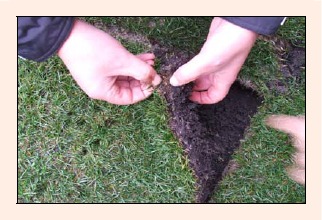
Turf sample from Camp Nou in January 2006 indicating ‘join’ between the portable squares.
Biographies

John Orchard
Employment
Team physician, Sydney Roosters (NRL)
Degree
MD PhD FACSP FACSM FFSEM(UK)
Research interests
Sports epidemiology
E-mail: johnorchard@injuryupdate.com.au

Gil Rodas
Employment
Team physician, FC Barcelona
Degree
MD
Research interests
Muscle metabolism in sport
E-mail: gil.rodas@fcbarcelona.cat
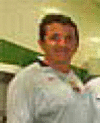
Lluis Til
Employment
Team physician, FC Barcelona
Degree
MD
Research interests
Football injuries
E-mail: lluis.til@fcbarcelona.cat

Jordi ArdevÒl
Employment
Orthopaedic Surgeon
Degree
MD, SEM (Spain)
Research interests
Sports injuries
E-mail: jardmet@menta.net

Ian Chivers
Employment
Sports turf consultant
Degree
Turfgrass science
Research interests
Link between turf profile and sports injury
E-mail: ian@nativeseeds.com.au
References
- Agel J., Arendt E., Bershadsky B. (2005) Anterior Cruciate ligament injury in National Collegiate Athletic Association basketball and soccer: A 13-Year review. American Journal of Sports Medicine 33, 524-531 [DOI] [PubMed] [Google Scholar]
- Arendt E., Agel J., Dick R. (1999) Anterior cruciate ligament injury patterns among collegiate men and women Journal of Athletic Training 34, 86-92 [PMC free article] [PubMed] [Google Scholar]
- Arendt E., Dick R. (1995) Knee injury patterns among men and women in collegiate basketball and soccer. NCAA data and review of the literature. American Journal of Sports Medicine 23, 694-701 [DOI] [PubMed] [Google Scholar]
- Chivers I., Aldous D., Orchard J. (2005) The relationship of Australian football grass surfaces to anterior cruciate ligament injury International Turfgrass Society Research Journal 10, 327-332 [Google Scholar]
- Cockerham S., Gibeault V., Van Dam J., Leonard M. (1989) Tolerance of cool season turfgrasses to sports traffic California Turfgrass Culture 39, 12-14 [Google Scholar]
- Ekstrand J., Nigg B. M. (1989) Surface-related injuries in soccer Sports Medicine 8, 56-62 [DOI] [PubMed] [Google Scholar]
- Gamez J., Alcantara E., Prat J. (2004) Estudio comparativo de la influencia de las superficies de hierba natural sobre parametros mecanicos y biomechanicos. El Instituti de Biomechnica Valencia, Valencia; 17.pages [Google Scholar]
- Griffin L., Albohm M., Arendt E., Bahr R., Beynnon B., DeMaio M., Dick R., Engebretsen L., Garrett W. (2006) Understanding and preventing noncontact Anterior Cruciate Ligament injuries. A review of the Hunt Valley II Meeting, January 2005. American Journal of Sports Medicine 34, 1512-1532 [DOI] [PubMed] [Google Scholar]
- Hewett T., Zazulak B., Myer G., Ford K. (2005) A review of electromyographic activation levels, timing differences, and increased anterior cruciate ligament injury incidence in female athletes British Journal of Sports Medicine 39, 347-350 [DOI] [PMC free article] [PubMed] [Google Scholar]
- McNitt A., Waddington D., Middour R. (1997) Traction measurement on natural turf. Safety in American Football. Hoerner E. American Society for Testing and Materials, 145-155 [Google Scholar]
- Milburn P. D., Barry E. B. (1998) Shoe-surface interaction and the reduction of injury in rugby union Sports Medicine 25, 319-327 [DOI] [PubMed] [Google Scholar]
- Neylan J., McGeary D., Robinson M. (1999) Prescription surface development: Sportsfield and arena management. International turf management handbook. Aldous D. Inkata Press, Melbourne: 281-298 [Google Scholar]
- Nigg B. M., Segesser B. (1988) The influence of playing surfaces on the load on the locomotor system and on football and tennis injuries Sports Medicine 5, 375-85 [DOI] [PubMed] [Google Scholar]
- Orchard J. (2001) The AFL Penetrometer study: work in progress Journal of Science and Medicine in Sport 4, 220-232 [DOI] [PubMed] [Google Scholar]
- Orchard J. (2004) Missed time through injury and injury management at an NRL club Sport Health 22, 11-19 [Google Scholar]
- Orchard J., Chivers I., Aldous D., Bennell K., Seward H. (2005) Rye grass is associated with a lower rate of non-contact anterior cruciate ligament injury than bermuda grass in Australian football. British Journal of Sports Medicine 39, 704-709 [DOI] [PMC free article] [PubMed] [Google Scholar]
- Orchard J., Powell J. (2003) Risk of knee and ankle sprains under various weather conditions in American football Medicine & Science in Sports & Exercise 35, 1118-23 [DOI] [PubMed] [Google Scholar]
- Orchard J., Seward H., McGivern J., Hood S. (2001) Intrinsic and extrinsic risk factors for anterior cruciate ligament injury in Australian Footballers. American Journal of Sports Medicine 29, 196-200 [DOI] [PubMed] [Google Scholar]
- Rogers J. I., Waddington D. (1990) Portable apparatus for assessing impact characteristics of athletic field surfaces. Natural and artificial playing fields: Characteristics and safety features STP 1073. Morehouse C. American Society for Testing and Materials, Philadelphia: 96-110 [Google Scholar]
- Shelbourne K., Davis T., Klootwyk T. (1998) The relationship between intercondylar notch width of the femur and the incidence of anterior cruciate ligament tears: A prospective study American Journal of Sports Medicine 26, 402-408 [DOI] [PubMed] [Google Scholar]
- Shelbourne K., Facibene W., Hunt J. (1997) Radiographic and intraoperative intercondylar notch width measurements in men and women with unilateral and bilateral anterior cruciate ligament tears Knee Surgery, Sports Traumatology and Arthroscopy 5, 229-233 [DOI] [PubMed] [Google Scholar]
- Turgeon A. (1999) Turfgrass management. Simon & Schuster, Upper Saddle River, NJ [Google Scholar]


